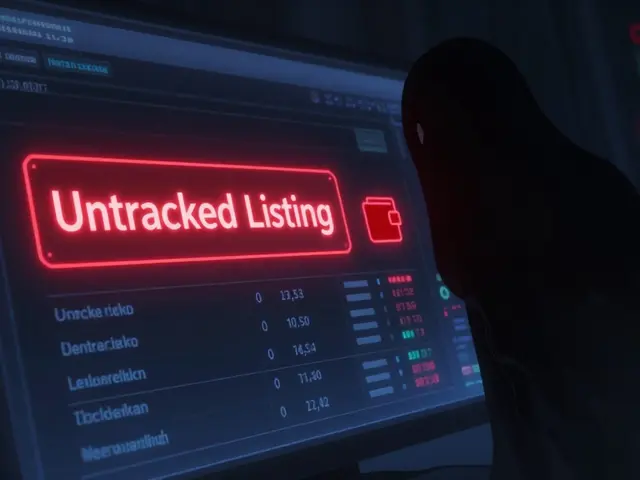Sanctions Evasion Risk Calculator
This tool estimates the probability of detection when attempting to bypass crypto sanctions based on transaction characteristics. Remember: crypto is not anonymous. Every transaction is visible on public blockchains.
Trying to bypass crypto restrictions isn’t a technical hack-it’s a legal gamble with serious consequences. Governments and international bodies aren’t blind to crypto’s potential for evasion. They’ve spent years building tools, laws, and enforcement networks specifically to catch it. The idea that blockchain is anonymous? That’s outdated. Today, crypto sanctions evasion is one of the most monitored financial crimes in the world.
Why Crypto Isn’t the Secret Weapon You Think It Is
Many believe crypto offers a way to slip through financial sanctions because it’s decentralized and peer-to-peer. But that’s exactly what makes it easier to track. Every Bitcoin or Ethereum transaction is permanently recorded on a public ledger. No bank statements get shredded. No digital trails vanish after five years. Blockchain analytics firms like Chainalysis and Elliptic can trace over 98% of transactions on major networks. That’s not speculation-it’s fact. In 2023, these firms detected 99.2% of transactions linked to sanctioned Russian entities, up from 87% in 2021. The system isn’t perfect, but it’s far more effective than most assume.Privacy coins like Monero (XMR) are often cited as the solution. But even they’re not foolproof. Chainalysis reports only 65% traceability for Monero, meaning 35% of transactions might evade detection. That sounds promising-until you realize that’s still a 65% chance of getting caught. And if you’re moving large sums, even one flagged transaction can trigger a full investigation. Plus, most exchanges now block Monero deposits outright. You can’t move millions through Monero without drawing attention.
Who’s Watching-and How
The U.S. Department of the Treasury’s Office of Foreign Assets Control (OFAC) maintains a list of over 1,571 crypto wallet addresses tied to sanctioned individuals and entities as of December 2023. If you send or receive funds from any of those addresses, you’re already under scrutiny. The Financial Crimes Enforcement Network (FinCEN) has defined clear red flags: transactions from IP addresses in high-risk jurisdictions, transfers to blacklisted wallets, or use of decentralized exchanges based in unregulated countries.Major exchanges like Coinbase and Binance aren’t waiting for regulators to force their hand. After Russia’s invasion of Ukraine in February 2022, Coinbase froze 25,000 Russian accounts holding $225 million in assets within 48 hours. Binance required proof of address for all Russian users with over €10,000 in holdings by March 15, 2022. These aren’t isolated actions-they’re industry standards now. Exchanges that don’t comply risk losing their banking relationships, licenses, or facing criminal charges.
Even decentralized finance (DeFi) protocols aren’t immune. The EU’s Markets in Crypto-Assets Regulation (MiCA), which took full effect in 2024, requires all crypto service providers to implement real-time sanctions screening. By December 2024, every platform serving EU users must block transactions involving OFAC-listed addresses. Failure to do so can result in fines up to 5% of global turnover.
The Legal Consequences Are Real-and Getting Harsher
In November 2023, the U.S. Department of Justice charged two Russian nationals with attempting to evade $1.3 billion in sanctions using cryptocurrency. This was the first-ever criminal prosecution specifically for crypto-based sanctions evasion. It wasn’t a warning. It was a precedent.Individuals aren’t the only targets. Companies face massive penalties. Nexo Inc. paid $22.5 million in January 2023 to settle charges from five U.S. states for offering unregistered securities and failing to screen users properly. Coinbase has been hit with coordinated enforcement actions in nine states, including California and New York, for allegedly violating securities laws and lax compliance controls. These aren’t minor fines. They’re existential threats to businesses.
Under U.S. law, violating OFAC sanctions can lead to criminal charges with penalties of up to $20 million per violation and 30 years in prison. The U.S. Department of Justice’s Cryptocurrency Enforcement Framework, released in 2020, explicitly states that virtual currencies “undermine traditional financial markets and harm the interests of the United States and its allies.” That’s not just a policy statement-it’s a legal declaration of war on evasion.

Why Traditional Methods Still Dominate
Despite all the hype, crypto isn’t the main tool for sanctions evasion. According to a 2023 report by the Center for Strategic and International Studies (CSIS), cryptocurrency accounted for just 0.01% of estimated $148 billion in Russian sanctions evasion attempts. The real methods? Commodity trading (42%), third-country intermediaries (38%), and physical cash smuggling (15%).Why? Because crypto is too transparent. Moving $10 million through shell companies in the UAE or shipping gold through Turkey leaves fewer digital breadcrumbs than sending it through a crypto wallet. Even if you use multiple wallets, tumblers, or mixers, blockchain analytics tools can still follow the trail. And if you’re dealing with large sums, the timing, volume, and patterns are too obvious to hide.
Plus, the infrastructure to move large amounts of crypto without detection simply doesn’t exist at scale. You need liquidity, trusted counterparties, and exchange access-all of which are now tightly monitored. The more you try to obscure your activity, the more you trigger automated alerts.
The Real Weakness: Human Error and Poor Compliance
The biggest risk isn’t the technology-it’s the people using it. A September 2023 Government Accountability Office report found that 37% of crypto transactions involving Russian entities during the first six months of the Ukraine conflict lacked sufficient identifying information. That’s not because crypto is anonymous. It’s because some platforms, especially smaller ones, didn’t implement proper Know Your Customer (KYC) checks.Until May 2022, Binance allowed users to transact up to $1,000 without any identity verification. That loophole was closed, but it’s a reminder: enforcement gaps exist where compliance is weak. If you’re trying to evade sanctions, you’re not fighting the blockchain-you’re fighting the people who manage the platforms. And most of them are now legally obligated to report you.
Platforms that combine blockchain analytics with strong KYC see dramatic improvements. Kraken reduced false positives in sanctions screening from 22% to 3.7% between 2021 and 2023 while increasing detection rates from 68% to 94.2%. That’s not magic-it’s disciplined compliance.

What’s Next? The Walls Are Closing In
Regulators aren’t slowing down. The U.S. Congress introduced the Digital Asset Sanctions Compliance Act in September 2023, which would extend sanctions requirements to decentralized applications and smart contracts. That means even if you avoid exchanges entirely, using a DeFi protocol to move funds could land you in court.The Financial Action Task Force (FATF) projects that by 2026, traceability of major cryptocurrencies will reach 99.8% through coordinated global efforts. That’s not a guess. It’s the result of five years of regulatory alignment, shared intelligence, and advanced analytics tools. Privacy coins, decentralized networks, and offshore platforms won’t save you when every node in the network is monitored.
The message is clear: if you’re trying to circumvent crypto restrictions, you’re not outsmarting the system. You’re walking into a trap designed to catch you. The technology isn’t your ally-it’s your liability.
What Should You Do Instead?
If you’re in a jurisdiction with strict crypto controls, the smart move isn’t to evade-it’s to comply. Understand your local laws. Use licensed exchanges. Keep records. If you’re a business, invest in proper compliance tools. The cost of getting caught isn’t just financial-it’s reputational, legal, and personal.There’s no legal shortcut. No clever trick. No anonymous wallet that will save you. The only safe path is the one that follows the rules.
Is it illegal to use cryptocurrency in countries with sanctions?
Using cryptocurrency itself isn’t illegal in most places. But if you’re using it to bypass sanctions imposed by the U.S., EU, UK, or other jurisdictions, then yes-it’s a criminal offense. The issue isn’t owning crypto. It’s using it to move money that’s been blocked by international sanctions. OFAC and similar agencies target transactions, not holdings.
Can you get caught using Monero or other privacy coins?
Yes. While privacy coins like Monero are harder to trace, they’re not invisible. Exchanges block them. Wallets flag them. Law enforcement tracks patterns-like large transfers from known sanctioned addresses to Monero wallets, then back to Bitcoin. Chainalysis and other firms have developed methods to link even privacy coin transactions to real identities. The risk isn’t zero-it’s just higher.
Do exchanges report suspicious crypto activity?
Yes, and they’re legally required to. Under MiCA, FATF guidelines, and U.S. regulations, exchanges must report transactions tied to sanctioned entities, suspicious behavior, or large unverified transfers. Coinbase, Kraken, Binance, and others now have dedicated compliance teams that flag and freeze accounts automatically. Ignoring this isn’t an option.
What happens if you accidentally send crypto to a sanctioned wallet?
If you didn’t know the address was sanctioned and you acted in good faith, you’re unlikely to face criminal charges. But your funds will be frozen, and you’ll need to prove your innocence through documentation. Many users have had wallets locked for months while regulators investigate. The burden of proof is on you-not the authorities.
Can decentralized exchanges (DEXs) help you avoid sanctions?
No. While DEXs don’t require KYC, they’re still vulnerable to blockchain analytics. The U.S. and EU are moving to regulate DEXs directly. The Digital Asset Sanctions Compliance Act would require DEXs to block transactions involving sanctioned addresses. Even if you use a DEX, your wallet address can still be flagged, frozen, or linked to your identity through IP logs or transaction patterns.
How do regulators know which crypto addresses belong to sanctioned individuals?
Regulators use blockchain analytics firms like Chainalysis and Elliptic to trace transactions back to known entities. They cross-reference public blockchain data with KYC records from exchanges, seized wallets from past cases, and intelligence from law enforcement. Many sanctioned addresses were identified after exchanges froze accounts during the Russia-Ukraine conflict and handed over wallet data to authorities.
Are there any legal ways to use crypto in sanctioned countries?
Only if you’re operating under a specific license or exemption from OFAC or equivalent agencies. For example, humanitarian organizations can apply for special licenses to send crypto for aid. But for individuals or businesses, there’s no legal gray area. If sanctions apply to you, using crypto to move value across borders is prohibited-no exceptions.











